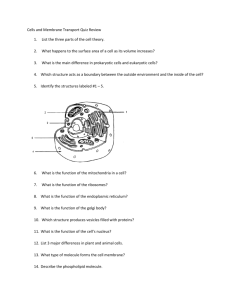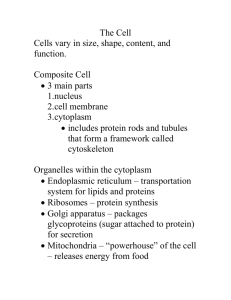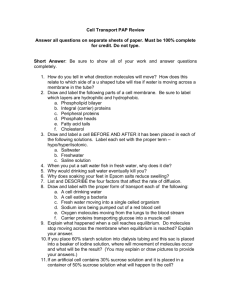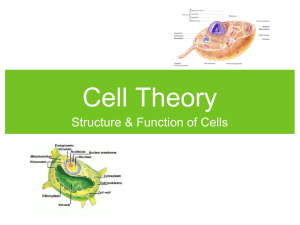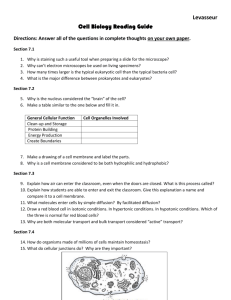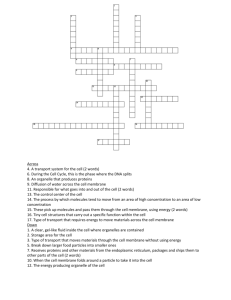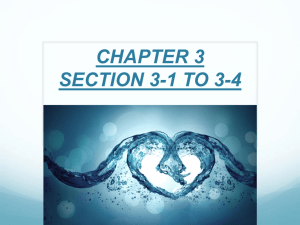Cell Transport across the cell membrane Kathy Jardine and Brian Evans
advertisement
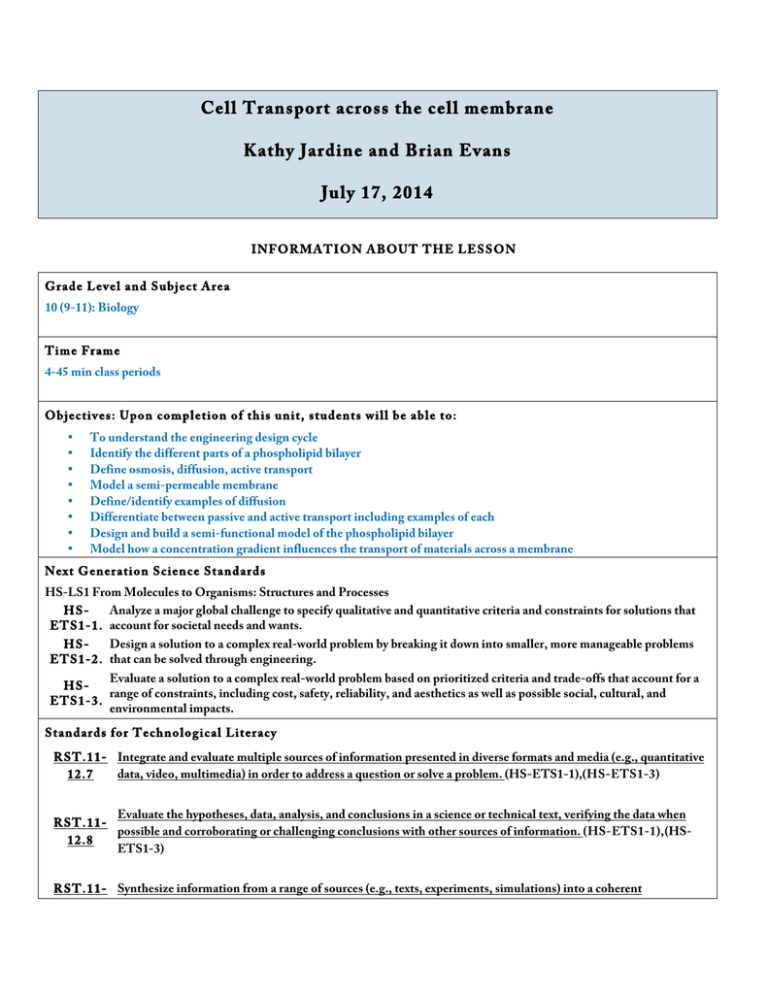
Cell Transport across the cell membrane Kathy Jardine and Brian Evans July 17, 2014 INFORM ATION ABOUT THE LESSON Grade Level and Subject Area 10 (9-11): Biology Time Frame 4-45 min class periods Objectives: Upon completion of this unit, students will be able to: • • • • • • • • To understand the engineering design cycle Identify the different parts of a phospholipid bilayer Define osmosis, diffusion, active transport Model a semi-permeable membrane Define/identify examples of diffusion Differentiate between passive and active transport including examples of each Design and build a semi-functional model of the phospholipid bilayer Model how a concentration gradient influences the transport of materials across a membrane Next Generation Science Standards HS-LS1 From Molecules to Organisms: Structures and Processes HSAnalyze a major global challenge to specify qualitative and quantitative criteria and constraints for solutions that ETS1-1. account for societal needs and wants. HSDesign a solution to a complex real-world problem by breaking it down into smaller, more manageable problems ETS1-2. that can be solved through engineering. Evaluate a solution to a complex real-world problem based on prioritized criteria and trade-offs that account for a HSrange of constraints, including cost, safety, reliability, and aesthetics as well as possible social, cultural, and ETS1-3. environmental impacts. Standards for Technological Literacy RST.11- Integrate and evaluate multiple sources of information presented in diverse formats and media (e.g., quantitative 12.7 data, video, multimedia) in order to address a question or solve a problem. (HS-ETS1-1),(HS-ETS1-3) Evaluate the hypotheses, data, analysis, and conclusions in a science or technical text, verifying the data when RST.11possible and corroborating or challenging conclusions with other sources of information. (HS-ETS1-1),(HS12.8 ETS1-3) RST.11- Synthesize information from a range of sources (e.g., texts, experiments, simulations) into a coherent 12.9 understanding of a process, phenomenon, or concept, resolving conflicting information when possible. (HSETS1-1),(HS-ETS1-3) Common Core State Standards in M athematics M P.2 Reason abstractly and quantitatively. (HS-ETS1-1),(HS-ETS1-3),(HS-ETS1-4) Common Core State Standards in English and Language Arts RST.11- Cite specific textual evidence to support analysis of science and technical texts, attending to important distinctions 12.1 the author makes and to any gaps or inconsistencies in the account. (HS-LS1-1) Write informative/explanatory texts, including the narration of historical events, scientific procedures/ experiments, WHST.9- or technical processes. (HS-LS1-1) 12.2 WHST.9-12.9 Draw evidence from informational texts to support analysis, reflection, and research. (HS-LS1-1) Prior Learning Any previous learning about cellular membranes, cellular transport would be used in this lesson. M aterials Your textbook, your own notes, beaker with water, food coloring, computer with internet access, for detailed description of materials see Appendix A. Day 1: LESSON IM PLEMENTATION Objective: Upon completion of this lesson, students will be able to: To understand the engineering design cycle Pre-Assessment Do you know what engineering design cycle? And how it relates to biology? Procedures Time: 45 min – 1 class period 1. Introduce the engineering design cycle and relate it to the scientific method 2. Discuss the work of biomedical engineers. 3. Give students a list of diseases that are caused by a malfunctioning plasma membrane. 4. Start to introduce phospholipid bilayer components. 5. Put food coloring in a beaker filled with water: discuss what is occurring. (diffusion) 6. Show animation from internet if necessary to visualize the diffusion and osmosis processes. Formative Assessment Classroom discussion Purpose: introduce experimental design Closure Reflect: 1.) What did you learn today? 2.) What are some ways that biomedical engineers are useful in the medical field? 3.) How is diffusion different than osmosis? Summative Assessment At the end of the hour, have groups of two try and list all of the parts of the experimental design process in their notebooks. Orally discuss and write this on the board. Day 2: LESSON IM PLEM ENTATION Objective: Upon completion of this lesson, students will be able to: • • • • • Identify the different parts of a phospholipid bilayer Define osmosis, diffusion, active transport Define semi-permeable membrane Define/identify examples of diffusion Define/identify examples of active transport Pre-Assessment Fill up a beaker with tap water. Discuss what will happen when food coloring is added to it. Drop food coloring in the beaker. Observe and discuss. Procedures Time Instructional Strategies/Learning Tasks 45min1 class period 1. Review topics started on day1 2. Review phospholipid bilayer concepts 3. Teach diffusion and active transport using analogies and pictures. 4. Show animations from websites if additional resources are needed. Purpose: introduction to cellular membranes and their components Formative Assessment THINK-PAIR-SHARE: (Have students answer questions about classroom discussion): 1. Differentiate between diffusion and facilitated diffusion. Give examples of molecules that experience each process. 2. Define active transport and give an example of a cell or organism that experiences this. 3. Discuss how diffusion and active transport are different- (may use a Venn diagram). W hy is it necessary for a cell or organism to have both? Closure Discuss the THINK-PAIR-SHARE; go over any misconceptions. Summative Assessment Discuss the THINK-PAIR-SHARE; go over any misconceptions. Day 3-4: LESSON IM PLEM ENTATION Objective: Upon completion of this lesson, students will be able to: Design and build a semi-functional model of the phospholipid bilayer. Pre-Assessment What are all of the components of a phospholipid bilayer? Have a student write them on the board; add to this list if necessary. Procedures Time: 45 min – 2 class periods 1. Give all students a list of materials and what they need to accomplish. 2. They should write down all of their ideas (5 min). 3. In groups they should compare ideas and pick the one they think is best (or combine them). 4. In their groups, students should build their model of the cell membrane. They will need to include definitions as well as labels of each of the following (see Appendix B- analysis questions) 5. Their model will have to allow specific molecules to go through it (items that will represent water, carbon dioxide, oxygen, glucose, sodium, etc.) 6. W hen they are completed, these will be tested to see if they work. It will be tested against a rubric (Appendix A) Purpose: build a functional cell membrane Formative Assessment Testing their product for functionality Closure Have a class discuss on what everyone has learned. Review any questions still remaining. Prepare for a quiz. Summative Assessment Quiz time! Some ideas and parts of this lesson plan were inspired by the lesson “Keepers of the Gate” from the website: http://www.teachengineering.org/ on July 18, 2014 Appendix A- Engineering Design Project Handout Scenario: The plasma membrane plays an integral role in maintaining homeostasis by controlling what comes into and out of the cell. We have discussed how small defects that result in some loss of function of the plasma membrane can result in major disorders, such as Duchenne Muscular Dystrophy. Some small, non-polar molecules are able to cross the plasma membrane along the concentration gradient directly through the phospholipid bilayer. Other smaller charged molecules, like water and charged ions, are able to cross the membrane via channel proteins through the process of facilitated diffusion. Some substrates need to be pumped across the membrane against the concentration gradient (or may be too large to cross the membrane) and require an energy input and/or the help of carrier proteins to cross the membrane via active transport. In this design contest, you will be responsible for designing a 3-D model of a plasma membrane that must allow different substrates to cross it via a variety of “transport proteins.” Your model should demonstrate the phospholipid bilayer and incorporate channel proteins and carrier proteins that will be able to transmit four materials that represent different types of substrates that would need to enter/exit a cell. Here are the substances that will need to cross your model membrane, the type of cell transport they would require, and what will be representing each: O2/CO2 – simple diffusion – represented by sand Water and ions –facilitated diffusion via channel proteins – represented by water Glucose (moving against the gradient (ex)intestine)) – active transport via specialized transmembrane proteins – represented by a pom pom Mineral ions(moving against the gradient(ex) in plant roots))- active transport via specialized transmembrane proteins Materials: Styrofoam ball - $5.00 Tape (6”) - $ 3.00 Cotton balls (x5) -$3.00 Toothpicks (x10) - $ 2.00 Drinking Straw - $1.00 Coffee Stirrers (x5) – $2.00 Rubber Band – $3.00 Paper Clips (x 10) - $2.00 Craft Foam (2”x2”) - $2.00 String (6”) - $2.00 Cheese cloth (2”x2”) - $1.00 Pipe cleaner – $1.00 Aluminum Foil (2”x2”) - $1.00 Play-doh (1” ball) – $3.00 Q-tips (x25)-$3.00 Science Learning Community: Science and Engineering Lesson Plans Grading : -Structural Accuracy in modeling the membrane and membrane-bound proteins = 30% of Total Design Grade Points: 15 10 5 0 Requirements: The model successfully demonstrates the structure of the phospholipid bilayer and transport proteins. The membrane is a double layer and phospholipids are relatively similar to their actual structure. Transport proteins are not embedded in the membrane and/or carrier proteins cannot repeatedly modify their form to attach with their associated substrate, pass it through the membrane, and release it. The membrane is a double layer, however, the model does not demonstrate the structure of the phospholipids (phosphate heads and fatty acid tails). Transport proteins are not embedded in the membrane. Model in no way resembles the structure of a phospholipid bilayer. Transport proteins are not embedded in the membrane. It is not a bilayer. Amount of material that passed through the membrane (sand = 3 points, water = 4 points, ions large molecules = 4 points each) = 30% of Total Design Grade (15 points) Requirements: Sand and water will be massed before and after travelling through the membrane to determine the percentage of the substrate that was able to successfully cross the membrane. The class percentages will be divided into thirds. To receive all of the points for sand and/or water the percentage of sand and/or water that successfully pass through the group’s membrane must fall in the top 3rd of the class. Water will not be able to cross the membrane without a channel protein. If you do not build a channel protein, your group will receive a zero for that grade. Reusability on active transport pumps/carrier proteins = 20% of Total Design Grade Points: 10 7.5 5 2.5 Requirements: Carrier proteins can be reset to their original position (able to accept a new molecule (marble/pom pom) within 10 seconds Carrier proteins can be reset to their original position (able to accept a new molecule (marble/pom pom) within 30 seconds Carrier proteins can be reset to their original position (able to accept a new molecule (marble/pom pom) within 1 minute Carrier proteins cannot be returned to their original state after transferring the molecules through the membrane -Money Spent on model supplies (cost) = 20% of Total Design Grade Points: Requirements: 10 7.5 5 Total cost of materials used to build the model falls is in the lower 25% of the class totals. Total cost of materials used to build the model falls is in the lower 50% of the class totals. Total cost of materials used to build the model falls is in the lower 75% of the class totals. 2.5 Total cost of materials used to build the model is among the most expensive 25% of the class totals. Funded by an Elementary and Secondary Education Act Title IIb Wisconsin Improving Teacher Quality Grant in Partnership with the University of Wisconsin-Stout Page 6 Science Learning Community: Science and Engineering Lesson Plans Total Design Grade = __________ / 50 points Appendix B- Analysis questions Name__________________________________________________Hour_______ __Date______________ Define the following terms in your own words: 1. Cell membrane 2. Phospholipid a. Label the hydrophilic (head or tail) and the hydrophobic head or tail accordingly 3. Receptor and signal molecules 4. Selective permeability 5. Transport protein channels 6. Cholesterol component 7. Fluid mosaic model 8. Diffusion a. Example of particles that diffuse through a cell Funded by an Elementary and Secondary Education Act Title IIb Wisconsin Improving Teacher Quality Grant in Partnership with the University of Wisconsin-Stout Page 7 Science Learning Community: Science and Engineering Lesson Plans 9. Active transport a. Examples of particles that use active transport through a cell Answer the following questions referring to your model: 1. What part of your model represents the following: a. Hydrophobic tails? b. Hydrophilic heads? c. Transport (carrier) proteins d. channel proteins e. cholesterol 2. How is diffusion different from facilitated diffusion? Give an example of a molecule that does diffusion and one that does facilitated diffusion? 3. Differentiate between active transport and diffusion. 4. Explain how the swabs and straws actually represent the components of a real cell membrane. 5. Roll the bundle of cotton swabs between your hands. Do the individual swabs move? Without pulling the straw out can you move it between the swabs? How does this represent the fluid mosaic model? Funded by an Elementary and Secondary Education Act Title IIb Wisconsin Improving Teacher Quality Grant in Partnership with the University of Wisconsin-Stout Page 8 Science Learning Community: Science and Engineering Lesson Plans 6. What was the hardest part of building your model? 7. How did completing this project help with your understanding of how a cell membrane works in a cell? 8. What do you think would happen if one of the components to the cell membrane- say the transport proteins- all were stuck open? Stuck shut? Be descriptive and scientific in your answer. Funded by an Elementary and Secondary Education Act Title IIb Wisconsin Improving Teacher Quality Grant in Partnership with the University of Wisconsin-Stout Page 9
